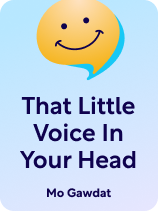

This article is an excerpt from the Shortform book guide to "That Little Voice In Your Head" by Mo Gawdat. Shortform has the world's best summaries and analyses of books you should be reading.
Like this article? Sign up for a free trial here.
What is the misinformation effect? What happens when your brain takes in inaccurate information?
One grave error that can cause your brain to misfire is if you feed it inaccurate information. If you want your brain to produce happiness, you must ensure that you’re feeding it the proper information to produce that result.
Keep reading to learn more about how the misinformation effect works in the brain.
The Four Types of Information
What is the misinformation effect? To understand what this effect is, you need to know what type of information your brain consumes. Mo Gawdat explains that our brain takes in four main categories of information:
1. Sensory information: This is information we observe with our five senses—things we see, hear, smell, touch, or taste. For example, someone is shouting—you know this because you heard it. These inputs are objectively accurate and true.
2. Interpretations: This information encompasses things we believe to be true based on our experiences and underlying beliefs. For example, there’s a fight happening—you know this because you hear shouting, and when there’s shouting, there’s a fight. However, these inputs are not objectively true and can be inaccurate.
3. Recurring thoughts and emotions: These thoughts and emotions crop up in your mind frequently and without any external trigger. For example, you’re driving to work and all of a sudden you start thinking that no one likes you, and you start feeling resentful. Our recurring thoughts tend to trigger our recurring emotions. These inputs are often untrue and inaccurate because they stem from interpretations.
4. Inaccurate takes: These are external sources of information and influence that, bit by bit, cause us to form an inaccurate concept of reality. For example, listening to your parents’ beliefs while you were growing up shapes your perception of reality. Or seeing models with perfect skin all over Instagram makes you think that having a pimple makes you flawed. These inputs are often untrue and inaccurate as they stem from curated or incomplete ideas of what things “should” be.
Gawdat explains that sensory information is the only type of information we can rely on to produce happiness. This is because it’s the only type of information that’s objectively true and accurate, and therefore, the only type of information that our brains can rationally understand and effectively act on. On the other hand, interpretations, recurring thoughts and emotions, and inaccurate takes are not objective truths and are often skewed negatively. Therefore, they tend to produce inaccurate understandings of reality that cause unhappiness. We’ll specify how inaccurate thoughts cause unhappiness in the sections below.
Inaccurate Information Skews Reality
Imagine you hear someone yelling (sensory information) but you feed this information to your brain as an interpretation—“people are fighting.” Your brain will process this information and tell you there’s a problem, which will produce anxiety and make you unhappy. Similarly, imagine you notice a pimple (sensory information) but you feed this information to your brain as an inaccurate take—“I have a flaw.” Your brain will process this information and tell you that you’re flawed, which will produce insecurity and make you unhappy.
However, neither of these scenarios needs to lead to negative emotions and unhappiness—yelling doesn’t equate to fighting, and having a pimple doesn’t equate to being flawed. Therefore, it’s not reality that makes you unhappy; it’s the inaccurate information about reality that you feed your brain.
| The Human Desire for Certainty Leads to Unhappiness Recent research on how humans handle ambiguity supports and adds to Gawdat’s claim. Scientists explain that humans are prone to making assumptions (or believing their interpretations) because of our evolutionary instinct to avoid ambiguity. When we make assumptions, we’re predicting the future, which eliminates ambiguity and increases safety by allowing us to prepare for potentially dangerous situations. However, our instinct to maintain safety by preparing for the worst means that when we make an assumption, there’s a much higher chance of it being negative than positive. As a result, a study found that the more assumption-prone someone is, the lower their well-being, self-esteem, and motivation are (negative assumptions make us unhappy). This would corroborate Gawdat’s claims that believing your assumptions makes you unhappy. |
Relying on Inaccurate Information Becomes Habit
Further, Gawdat explains that the more you feed your brain inaccurate information, the easier it is to make the same mistake in the future. This is due to neuroplasticity—every time you perform a task, think a thought, or feel an emotion, the neurons in your brain forge a path between the trigger and that action. The more you perform the action and send neurons down that path, the more prominent the path becomes, and the easier it is for the neurons to follow it in the future, even without being directed by a trigger. Eventually, that action becomes an ingrained habit. This is how recurring thoughts and emotions are formed.
For example, you see a pimple (trigger) and think you’re flawed (action). If you follow the “pimple flaw” to “I’m ugly” pathway often enough, you’ll eventually start to think “I’m ugly” without any trigger. (Shortform note: Gawdat explains that negative thoughts and emotions become habit due to neuroplasticity; however, some experts suggest there may be an additional reason—we’re actually addicted to them. When we experience negative thoughts and emotions like self-pity or guilt, the beta-endorphin and dopamine pathways are also used, which activate the “pleasure center” of our brain—the same area that lights up when people do drugs like cocaine, for example. This makes us want to continue thinking these thoughts to get the reward of endorphins and dopamine.)

———End of Preview———
Like what you just read? Read the rest of the world's best book summary and analysis of Mo Gawdat's "That Little Voice In Your Head" at Shortform.
Here's what you'll find in our full That Little Voice In Your Head summary:
- How to understand and program your brain to produce positive actions and emotions
- The four processing errors that cause our brains to produce unhappiness
- Why you should get into the flow state more often






